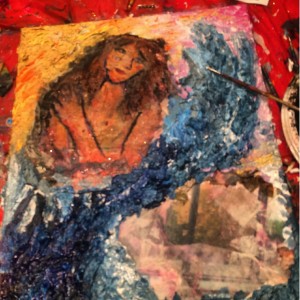Originally published on Amyoes.com on December 28, 2015 By Amy Oestreicher.
What is it about trauma that makes us continually panic after the trauma is over?
I’m reading Waking the Tiger by Peter Levine again to further understand why a danger that is no longer present can have an affect on us. I quote some of this remarkable book in my essay on “freezing” after sexual assault for Huffington Post.
Learn about my college mental health programs here.
After my sexual abuse, and then after the hospital traumas, I would fluctuate between very numb and dazed, or very hyper-alert and panicked.
You can read my essay on PTSD for Huffington Post here.
Reading this section about “running movements” made me draw some parallels for my hyperactivity. Maybe in my frantic spurts of movement, my body was instinctively trying to complete the escape from my abuser, or from the stifling hold of a ventilator after each of my 27 surgeries?

As Peter Levine writes, we are animals acting on our animal instincts when we encounter a danger in our lives in a heroic and desperate attempt to survive.
From my mixed media gallery: Fierce
He writes, “animals in the wild are not traumatized by routine threats to their lives, while humans, on the other hand, are readily overwhelmed and often subject to the traumatic symptoms of hyper arousal, shutdown and dysregulation. Trauma is a highly activated incomplete biological response to threat, frozen in time. For example, when we prepare to fight or to flee, muscles throughout our entire body are tensed in specific patterns of high energy readiness. When we are unable to complete the appropriate actions, we fail to discharge the tremendous energy generated by our survival preparations. This energy becomes fixed in specific patterns of neuromuscular readiness. The person then stays in a state of acute and then chronic arousal and dysfunction in the central nervous system. Traumatized people are not suffering from a disease in the normal sense of the word- they have become stuck in an aroused state. It is difficult if not impossible to function normally under these circumstances.”
So how do we get back to “normal” after trauma? How do we get our bodies to feel like they’re in the safe, present moment and not in the midst of danger?
We start slowly feeling the physical sensation in our bodies – or as I call it, calling on your superhero five senses…
I started to heal when I trusted these superheroes, and let these five senses guide back back into life.
I’d like to share some quotes from an old journal entry from 2007 with you on being out of body, to show you a bit of what that was like:
“I talk about feeling out of body so much that I think I’ve actually lost the true meaning of the phrase. It really means I don’t physically feel my body, literally. If I touch it, it feels strange, like it isn’t my own. Yesterday in the car my anxiety was shooting off the wall and I freaked out – I felt that red ball of thread spiraling and unwinding all over my chest and legs and strangling me whole, I felt hanging by a thread and not attached to anything.
When you feel your body, you are always home, you always feel safe and like you are in a safe container wherever you go or whoever you are with. If you live in your mind, then that is all you have, and anything can happen in your mind –fear can be a vicious demon who really can kill you in your imagination because your imagination isn’t anchored in your body, which should be a safe place to call home….
…But when you are in your body, you are grounded in reality – a tree is a tree and your body feels the fear that is pertinent in the present – so you only get scared of things that are really materialized on this earth. So when you cant feel your body the world is a scary place to be. It’s frustrating to know that I spend the whoel day trying to hide in my mind whether numbing out – any time I drop into my body I end up crying. I guess those are the residual tears that have to be washed away every time I get inside of myself.
Whenever I physically touch a part of me, I am always alarmed, it feels like I am touching a stranger, or being touched by a stranger, it startles me a bit. I physically can’t feel my body when I walk fast or numb out or stay in my mind, how weird is that that I am living in a shell that I don’t even know? Home is your body that you can carry with you wherever you go, otherwise you feel unnattached to anything.”
To remedy this, I discovered techniques from Peter Levine’s book – REALLY super-complicated therapeutic strategies…like BREATHING! Here’s what I wrote from that entry:
“I think to be at peace and be present at the same time I need to keep saying things out loud, like what I feel texturally, or singing, or taking deep breaths.”
Doing physically activities like dance or yoga helped me, but healing is never a straight path and I still struggled:
“I danced but nothing seemed to click into me, like breaking through the surface of skin, I couldn’t tell whether I was forcing my instincts or following them, and when my instincts aren’t intuitively guiding me it is really scary, like I am being governed by someone else – it is so scary having an outside voice boss you around. As soon as I start to try figuring out what I feel, I get that knot of tension. I am trying not to drown in my emotions today so I don’t go crazy, but I don’t feel like I’m touching my toes in it either.”
Healing a “dip” at a time:
So how do you “dip your toes” in learning to feel comfortable in the present, in your body?
Notice things throughout the day: “Oh, I see a tree, I see a chair,” and focus on how you feel in your body as you say it. Notice what is in your body and don’t judge it, move on to the next one.
Another thing that helped me is nature – specifically, TREES. This poem I wrote about trees describes my reverence for them, and Peter Levine draws a very important parallel in this quote:
“Resilient strength is the opposite of helplessness. The tree is made strong and resilient by its grounded root system. These roots take nourishment from the ground and grow strong. Grounding also allows the tree to be resilient so that it can yield to the winds of change and not be uprooted.
So how do we heal after trauma? How do we get ourselves to stop acting from the panicked place our bodies experience at the time of the initial life-altering jolt?
Check out some of my favorite mental health resources here.
We heal one step at a time. The important thing to know is, that it IS possible.
As Peter Levine says, “I have come to the conclusion that human beings are born with an innate capacity to triumph over trauma. I believe not only that trauma is curable, but that the healing process can be a catalyst for profound awakening—a portal opening to emotional and genuine spiritual transformation. I have little doubt that as individuals, families, communities, and even nations, we have the capacity to learn how to heal and prevent much of the damage done by trauma. In so doing, we will significantly increase our ability to achieve both our individual and collective dreams.”
You can hear him talk about how he came to this idea in this video:
Pretty cool right?
When a trauma – or any detour, for that matter – knocks you off your feet – it’s easy to feel confused, hopeless, helpless, and a stranger to the rest of the world, and to yourself.
But you’re not, and you can heal.
Maybe if more people starting talking about their own struggles, we’d create a more compassionate community. I’m a strong believer that we heal through community, love and support.
Compassion is the response to the suffering of others that motivates a desire to help.[1][2]
How will you show compassion today? For others and for yourself?
Trackbacks/Pingbacks
- The Best Way to Build Your List – Your Resilience List, That Is! – AmyOes – […] see some books I’ve been reading and my favorite recommendations, like Peter Levine’s Waking The Tiger, or some inspiring…
- “Hope Builds Resilience” Presentation at New England Educational Opportunity Association’s 40th Anniversary Milestones Conference – AmyOes – […] Amy shares a valuable resource for healing from PTSD: Peter Levine’s Waking The Tiger: […]







